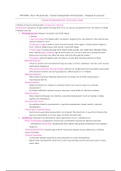Summary
PSYC1002 - Quiz 1 Study Notes - Ch 11&12 Summary - Human Development & Personality
- Institution
- Carleton University (CU )
- Book
- Psychology
This document contains my chapter / lecture study notes for quiz 1 in Professor Matthew Sorley's PSYC1002 class. The chapters covered are 11 and 12 of "Psychology: Themes and Variations" 5th Canadian edition as well as added in information from the lectures on human development and personality. key...
[Show more]



